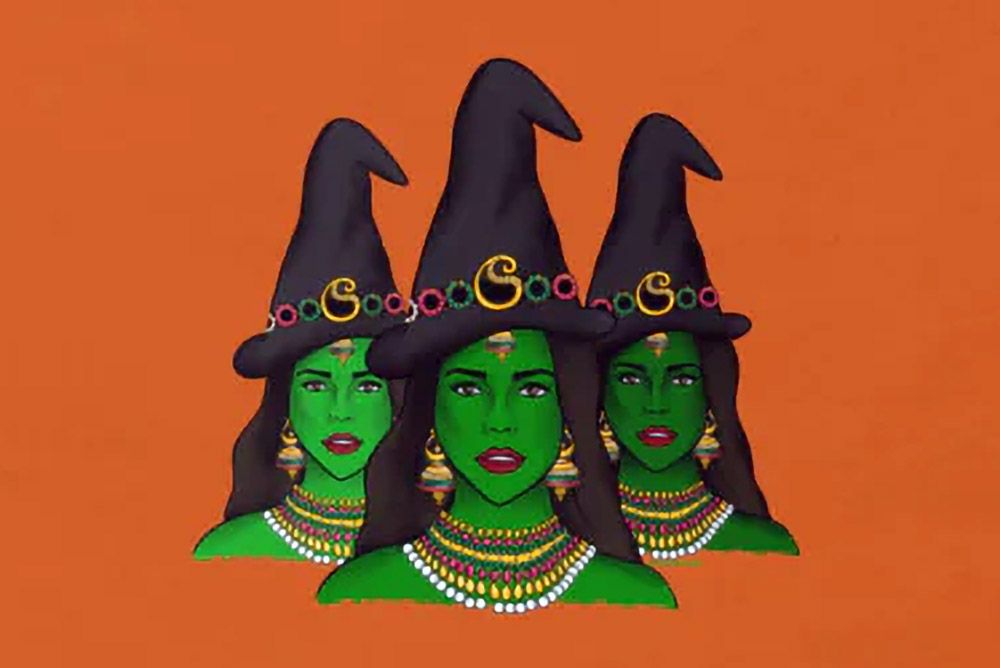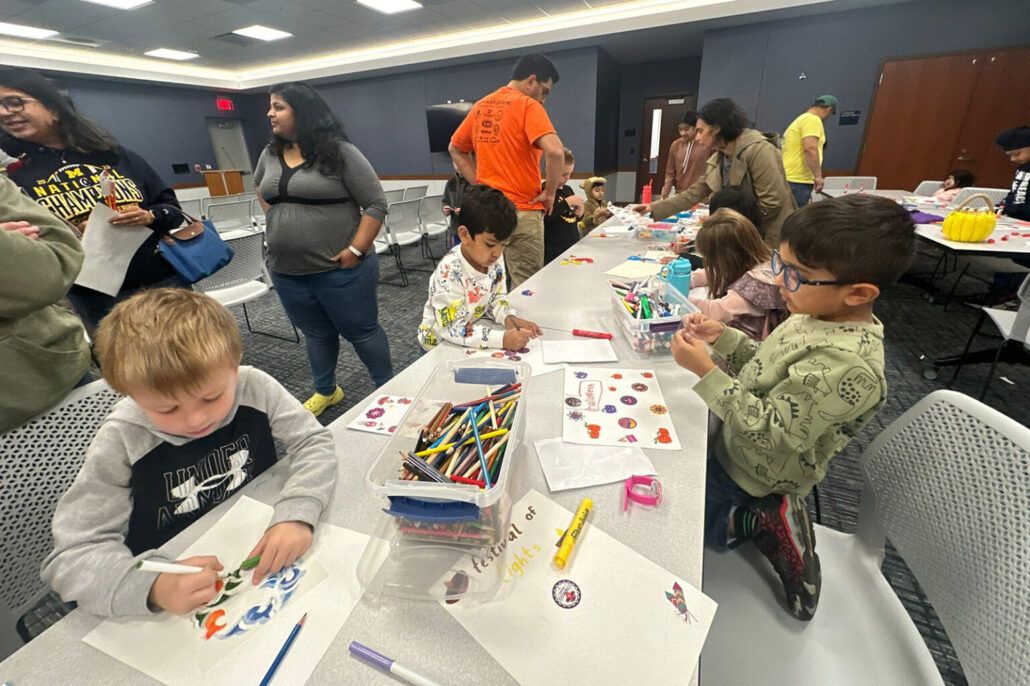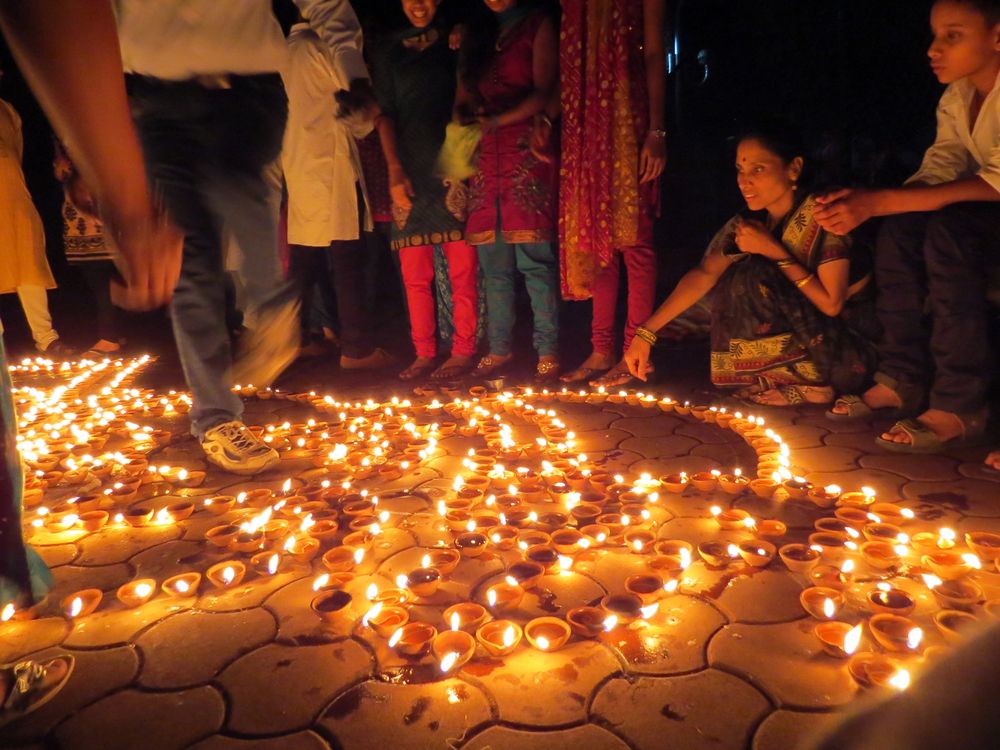The mashup holiday ‘Diwaloween’ celebrates light as the year turns dark
On Oct. 31, two seemingly opposing holidays, Diwali and Halloween, were celebrated as one by many South Asians for the first time since 2016.
News Story by Richa Karmarkar | Religion News Service
What happens when the religious festival celebrating the victory of good over evil coincides with the spookiest night of the year? Diwaloween. Or maybe Hallowali.
Mashups of Diwali and Halloween occur every few years as Diwali, a day on the lunar calendar that shifts from year to year on the Western calendar, falls on or around Halloween. This year the two coincide for the first time since 2016.
The made-up holiday takes the form of trick-or-treating at the temple, Bollywood-themed costume parties, sparklers lighting the night for both the evil-destroying goddess Lakshmi and little goblins. Diwaloween, say many South Asian Americans, is one of the best examples of the diaspora’s unique dual-belonging and could only happen in America.
“I think this is a sign of one of the many ways that Hindu and other South Asians who celebrate Diwali and festivals this time of year are making America their own in some way and participating in these rituals,” said Shana Sippy, associate professor of religion and chair of Asian studies at Centre College.
What are these celebrations about?
Diwali, one of the largest and most recognizable celebrations for South Asian of dharmic faiths, is celebrated by Hindus, Jains, Buddhists and Sikhs around the world. Those who observe the day traditionally wear their best new clothes, exchange sweets with neighbors, light oil lamps called diyas, draw colorful rangoli patterns with sand and send off fireworks.
Increasingly a secular holiday even in the India subcontinent, the holiday can trace its roots to several strands of Hindu mythological stories of Lord Ram, Lord Krishna and the goddess Kali. Diwali is considered an especially auspicious time to start something new.
Halloween, with its ghosts, ghouls and skeletons, often seemed in conflict with the season of light, renewal and hope to many immigrants who came to the United States. Manasi Arya, a 27-year-old social media content creator and fashion designer in New York, said her parents initially “couldn’t understand the point” of Halloween and often asked, “Why don’t you just dress up as an Indian princess?”
“All my friends at school, my neighbors, they were always wearing these really cool costumes that were just like a different character, but I was literally wearing a lengha,” said Arya, referring to a typical Indian dress.
Arya’s family eventually warmed up to the American ritual, even helping her paint Desi-style pumpkins for competitions, with henna art or a heavily made-up woman’s face.
‘Diwali-meets-Halloween’
The inspiration led Arya to launch a Diwali-meets-Halloween line of clothing and accessories that included Desi vampires, patterned ghosts and witches with saris and bindis.
On Diwaloween, said Arya, “It just so happens that two of our favorite holidays are happening in one day.”

The combined holiday also addresses the reality that the resources for traditional Diwali celebrations aren’t always available in the U.S.
“We don’t get to do the very typical, traditional things for Diwali, the way that you can do it in India, right?” Arya said. “So I think it’s cool to bring that American element into how we’ve been able to celebrate our Diwali here.”
Diwaloween even has its requisite holiday movie, thanks to Shilpa Mankikar, whose multigenerational comedy “Diwal’oween,” is about a diaspora family’s hijinks leading up to the holiday.
The film, currently being screened at cultural organizations across the U.S., is patterned after Mankikar’s own upbringing as a first-generation Indian in New Jersey, the state with the most South Asians in the country.
The film’s laughs come from the contradiction of a festival of lights clashing with a festival of darkness, Mankikar told RNS. “They are in opposition, and that’s like the comedy clash of it all.”
Mankikar, 47, grew up in a time when representation of Indian Americans in the media was restricted to misinterpretations and offensive stereotypes.
The next generation’s Diwali in America
But today non-South Asian Americans’ awareness and even celebration of Diwali has shot to an all-time high. The holiday has been recognized as a work holiday by several states and school districts, including New York City public schools, which will recognize it with a day off for the first time this year.
“Holidays are a good opportunity to learn about each other and also, with celebrating Indian culture, there’s so much color and dancing and food that people now are familiar with,” said Mankikar. “It’s such a rich culture, so it’s great too that it’s now in the mainstream. We’re kind of coming to it on our own terms as an American generation.”

Sippy pointed out that, as a result of its popularity, Diwali has taken on an air of all-American consumerism, pointing to a Diwali Barbie released earlier this year, or the packs of Diwali mithai (sweets), sparklers and other branded Diwali goods for gift-giving. Diwali’s adoption by the retail world is analogous to the corporatization of Hannukah, or “Chrismakkah.”
The professor said the urge to combine the two holidays points to a human need for connection and community in an age of atomization in American society.
“When (else) do we let our kids knock on strangers’ doors? We don’t often know even our neighbors’ names,” Sippy said. “Here you dress up and you buy things to give away to complete strangers.”
Though opposites in spirit, Sippy said the two celebrations create warmth amid darkness — “Halloween being the dressing up, this opening of doors, the sharing of food, and the lighting of light as we start to get darker earlier.”
Bringing light to others
Prasanna Jog, national coordinator for the charity SewaDiwali, said Diwali food and parties have gotten better over the two decades since he arrived in the U.S. But what has gotten left behind is a tradition of thinking of the less fortunate on Diwali, he said.
Jog co-founded SewaDiwali in 2018 as a reflection of the Hindu tenet of “seeing that everyone is happy,” and that inner growth happens when one “brings light to others.”
“As we gain economic prosperity, it’s even more imperative that we think of others,” said Jog, whose group of more than 450 contributing organizations has raised more than 2.2 million pounds of nonperishables for food pantries.
“Even though we may not be born here like our children were, we consider the United States our ‘karma-bhoomi’ (land of action),” he said. “Wherever you are, you need to contribute for the welfare or the betterment of the society, and it is through the power of selfless seva (service).”
And this year, volunteers send a special request for the little ones.
“We are just using that as an opportunity for the kids to have that courage to go door-to-door,” he said. “And in addition to asking for candy, they can also ask for some cans of food!”









